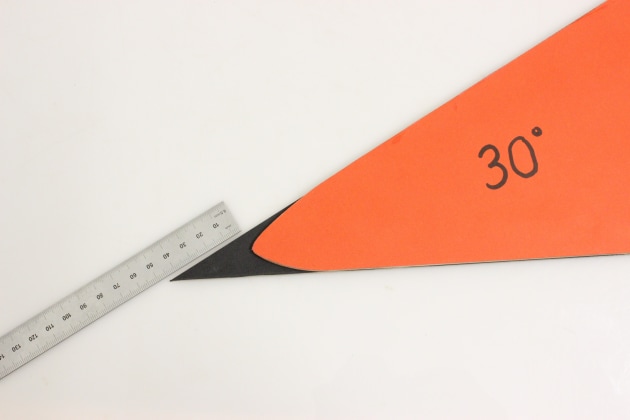Plane blade geometry, part 1
Words: Terry Gordon
The bevel angle you put on your plane blades makes a big difference to the effort required to plane wood and how long that blade will remain sharp enough to give you a nice smooth surface. This is the one angle in a plane that woodworkers control, and how you do it profoundly affects the performance of your plane.
What is bevel angle? As far as the function of your blade goes, it is the final bevel you put on the blade. So if you put a 45° micro bevel on a 30° primary bevel, your bevel angle is 45°, irrespective of how small the micro bevel is.
What is the optimum bevel angle for a plane blade? The correct answer is, as acute as possible without the blade edge chipping in use. I will give a more practical answer later after we look at some simple geometry, a sharpness test and some comprehensive blade testing results by two woodworkers. Steve Elliot and Brent Beach should be congratulated on their independent and significant bodies of work.
The photo above shows a blade bevel sharpened at 30° (in black) overlaid with a blade bevel that would be considered blunt (in red), and opposite is a blade sharpened at 50° with the blunt blade overlaid.
The shape of the rounded over blunt edges represented by the red cardboard cut-outs was extracted from Steve Elliot’s website where he took side-on magnified photos of a blade bevel after planing 800 lineal feet (245 lineal metres) of cherry wood. Both red cardboard cut-outs showing the blunt edge have been made to exactly the same size and shape at the edge so you can compare the amount of usable sharp edge on both 30° and 50° bevels.
From these magnified representations you can clearly see that a 30° bevel has three times the usable sharp edge when compared to the 50° bevel. The edge retention benefits of the 30° bevel are obvious and should be very good motivation for woodworkers to keep their blade bevels as acute as possible if they want to minimise the amount of sharpening they do and improve the performance of their plane.

Fig.1 An illustration of Steve Elliot’s blade sharpness testing device
Deciding when a blade is blunt is a subjective call, but Steve Elliot took this to another level and quantified it by using a sharpness testing device modelled on the diagram shown in fig.1. This device can accurately measure the force required for a blade edge to cut a piece of string. This gave him the means to make objective assessments of the optimum bevel angle that should be used in a plane, and accurate assessments of when a blade edge is blunt.
In essence, the more acute the blade bevel is the less force required to cut the string, and the blunter the blade edge gets, the force required to cut the string increases. His results can be read in full on his website, but for planing American cherry he concluded that a 31° bevel (including any micro bevel) gives the best results. When planing cherry he observed that less than 31° would produce chipping at the blade edge and to go beyond 31° would reduce the amount of wood in lineal feet (metres) that can be planed before the blade is blunt.
For harder or softer woods the optimum bevel angle may change slightly but if you develop a rule whereby you make plane bevels ‘as acute as possible without the blade edge chipping in use’, you will always be sharpening your bevel at the correct angle to get the best performance out of a sharp blade.

The type and quality of the steel in blades is also very important to edge holding and Steve Elliot and Brent Beach give lots of information about the types of steels they used in their testing and how they sharpened them. From their research you can judge for yourself which steels are the best from an edge retention and sharpening perspective.
In conclusion, no matter what blade steel your plane has, if you use the correct bevel angle geometry sharpened properly, this will have a far more profound effect on the performance of your plane simply because you have maximised the usable sharp edge on your blade.
Part 2 will look at another aspect of plane blade geometry that has a profound effect on planing performance.
Terry Gordon is a toolmaker in Alstonville, NSW. For more information on correct bevel angles see www.hntgordon.com.au
First published in Australian Wood Review, issue 97.


